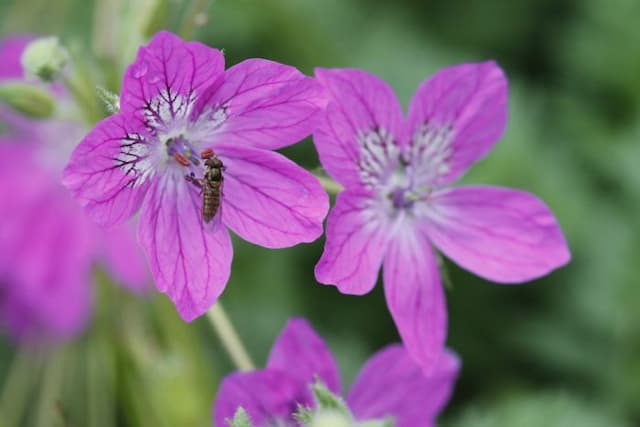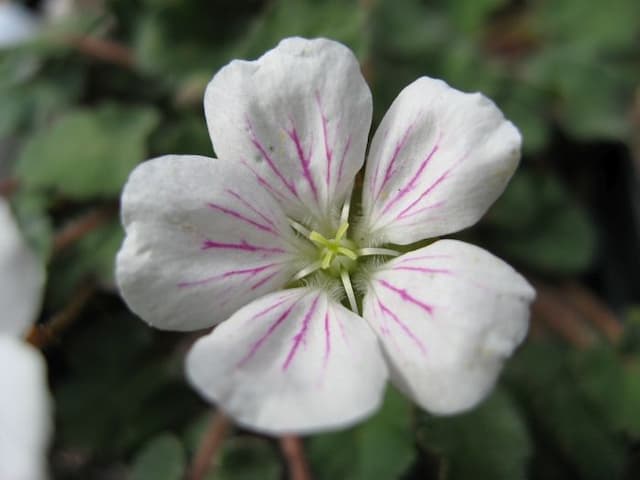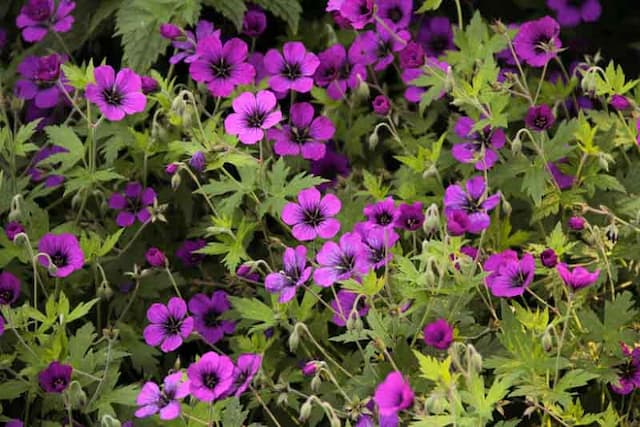Cranesbill Geranium 'Nimbus'

ABOUT
The Geranium 'Nimbus' is a visually pleasing plant that boasts lush green foliage. The leaves of the Geranium 'Nimbus' are intricately shaped with a slightly serrated edge, giving them a unique texture. They form a dense, mounded shape, providing a lush backdrop for the flowers. The flowers themselves are a remarkable feature, displaying an eye-catching shade that ranges from deep violet to lilac with subtle veining. These blooms are rounded with five petals that spread out from the center, creating a classic geranium shape. The petals may have a slight ruffled appearance, adding to the plant's ornamental value. These flowers cluster atop long slender stems that rise gracefully above the foliage, giving the plant an airy, delicate look. The Geranium 'Nimbus' tends to bloom prolifically, which can give the plant a vibrant, colorful presence in any garden space where it is planted. Overall, the Geranium 'Nimbus' is a plant that combines attractive foliage with striking flowers, making it a favorite among gardeners who seek to add a pop of color and texture to their garden without the consideration of the plant's dimensions.
About this plant
 Names
NamesFamily
Geraniaceae.
Synonyms
Cranesbill, Hardy Geranium.
Common names
Pelargonium 'Nimbus'.
 Toxicity
ToxicityTo humans
Geraniums, including the variety 'Nimbus', are generally considered non-toxic to humans. However, ingesting any part of the plant may cause mild gastrointestinal upset in some individuals. There is no documented case of severe poisoning from geraniums, but consumption should still be avoided.
To pets
Geraniums can be toxic to pets, particularly cats and dogs. The ingestion of this plant can result in symptoms such as vomiting, anorexia, depression, and dermatitis. In severe cases, geranium poisoning may cause renal failure. It is important to prevent pets from ingesting any part of the plant to avoid these potential consequences.
 Characteristics
CharacteristicsLife cycle
Perennials
Foliage type
Deciduous
Color of leaves
Green
Flower color
Blue
Height
1-2 feet (30-60 cm)
Spread
1-2 feet (30-60 cm)
Plant type
Herb
Hardiness zones
5
Native area
Mediterranean
Benefits
 General Benefits
General Benefits- Attracts Pollinators: Geranium 'Nimbus' draws bees and butterflies, which are vital for pollination.
- Drought Tolerant: Once established, it can withstand periods of low water, making it suitable for xeriscaping and reducing water usage.
- Low Maintenance: Requires minimal care once established, reducing the need for frequent attention.
- Long Blooming Season: Provides color and interest in the garden with its long flowering period from spring to fall.
- Deer Resistant: Its scent and taste tend to deter deer, reducing damage to the garden.
- Easy to Propagate: Can be easily propagated from cuttings or division, allowing gardeners to create more plants economically.
- Versatile Use: Suitable for borders, containers, rock gardens, and as ground cover, making it a flexible choice for different garden designs.
- Color Variety: Offers a range of colors through its blooms, which can enhance the visual appeal of any garden space.
- Aesthetic Appeal: Its finely cut foliage and clustered flowers add texture and form to the garden landscape.
 Medical Properties
Medical PropertiesThis plant is not used for medical purposes.
 Air-purifying Qualities
Air-purifying QualitiesThis plant is not specifically known for air purifying qualities.
 Other Uses
Other Uses- Garden Border Accent: Geranium 'Nimbus' can be used to create a lush border in garden beds, providing a striking contrast when planted alongside plants with solid green foliage.
- Natural Pest Repellant: Some gardeners use Geraniums to repel insect pests, as they are believed to have natural pest-repelling properties.
- Companion Planting: Geranium 'Nimbus' can be planted among vegetables like tomatoes and peppers to help repel common garden pests without the use of chemicals.
- Bouquet Filler: The foliage and flowers of Geranium 'Nimbus' can be cut and used in floral arrangements to provide a delicate, feathery filler material.
- Photography Prop: With its attractive foliage and blossoms, Geranium 'Nimbus' serves as an excellent photography prop for garden photographers.
- Culinary Decoration: Fresh Geranium 'Nimbus' flowers can be used to add a splash of color to salads and desserts, though they are not commonly known for edible use.
- Art and Crafts: The leaves and flowers of Geranium 'Nimbus' can be pressed and used in art projects such as botanical prints or in craft activities.
- Education: Geranium 'Nimbus' can be used in educational settings to teach about plant growth habits, pollination, and botany.
- Cultural Events: During certain festivals or events, Geranium 'Nimbus' may be used as a decorative element due to its vibrant and abundant blooms.
- Dye Source: Though not a well-known use, some species of Geranium can be used to create natural dyes, and Geranium 'Nimbus' may offer this potential on a small scale.
Interesting Facts
 Feng Shui
Feng ShuiThe Geranium is not used in Feng Shui practice.
 Zodiac Sign Compitability
Zodiac Sign CompitabilityThe Geranium is not used in astrology practice.
 Plant Symbolism
Plant Symbolism- Unexpected Friendship - The geranium flower often represents unexpected friendship or a surprise encounter that leads to a lasting bond.
- True Friendship - Geraniums symbolize true friendship because of their long-lasting nature and versatile beauty, similar to the enduring qualities of a deep and true friendship.
- Folly or Stupidity - In some floriography (language of flowers), geraniums have been used to symbolize folly or foolishness, possibly due to some varieties' bold and sometimes overwhelming presence.
- Comfort - Geraniums are often associated with comfort, as their pleasant scent and ease of care can provide a soothing presence in a home or garden.
- Positive Emotions - They can represent happiness and positive emotions because of their bright and colorful flowers that uplift the spirits.
- Healing - The geranium is believed to have healing properties in folklore, symbolizing a wish for good health and recovery.
 Water
WaterFor the Geranium 'Nimbus', commonly known as Cranesbill, water deeply once every week during the growing season, ensuring that the soil is damp but not waterlogged. It typically requires about one gallon of water per watering session for an outdoor plant, depending on the size and environmental conditions. During hot, dry spells, you may need to water more frequently, while in cooler or rainy periods, watering can be reduced. Always check the top inch of the soil before watering; if it feels dry to the touch, it's time to water. Avoid overhead watering to minimize the risk of leaf diseases.
 Light
LightCranesbill geraniums thrive in a location with full sun to partial shade. They perform best when they receive at least 4 to 6 hours of sunlight per day. However, in hotter climates, providing some afternoon shade can help prevent the leaves from scorching. Ideal light conditions ensure vibrant blooms and healthy plant growth.
 Temperature
TemperatureCranesbill geraniums prefer moderate temperatures and can typically withstand minimum temperatures down to 20 degrees Fahrenheit for short periods. They grow best within the range of 60 to 70 degrees Fahrenheit but can survive up to about 80 degrees Fahrenheit. Sudden frost below the minimum can damage or kill the plant, so provide protection or consider bringing potted specimens indoors during cold spells.
 Pruning
PruningCranesbill geraniums should be pruned to remove dead or yellowing leaves and spent flowers, which encourages new growth and better air circulation. Prune lightly throughout the growing season as needed, focusing on shaping the plant and maintaining its size. The best time for a more thorough pruning is late winter or early spring, just before new growth begins.
 Cleaning
CleaningNot needed
 Soil
SoilGeraniums prefer well-draining soil with a pH between 6.0 and 7.0; mix peat, compost, perlite, and a bit of lime to adjust pH.
 Repotting
RepottingRepot geraniums annually in early spring to refresh the soil and accommodate root growth.
 Humidity & Misting
Humidity & MistingGeraniums thrive in average room humidity levels; they do not require high humidity environments.
 Suitable locations
Suitable locationsIndoor
Place in bright indirect light and keep soil moderately moist.
Outdoor
Full sun to partial shade, well-draining soil, and even moisture.
Hardiness zone
10-11 USDA.
 Life cycle
Life cycleThe life cycle of the Geranium 'Nimbus', commonly known as the Nimbus Geranium, begins with seed germination, which occurs when the environmental conditions are favorable—typically in spring or early summer. The seeds develop into small seedlings with characteristic geranium foliage. As they mature, they form a robust root system and foliage increases through the vegetative growth stage. During the flowering stage, the Nimbus Geranium produces its distinctive flowers, often in shades of blue or lavender, which can occur multiple times throughout the growing season if deadheaded regularly. After flowering, the plant sets seeds, which can be collected for propagation or left to self-sow if conditions allow. As a perennial, the Nimbus Geranium will enter a period of dormancy in the fall and winter, dying back to the ground before re-sprouting from its rootstock the following spring.
 Propogation
PropogationPropogation time
Spring to Summer
Propogation: The Geranium 'Nimbus' is commonly propagated through stem cuttings, which is the most popular method due to its efficiency and ease. The ideal time to take cuttings for propagation is during late spring or early summer when the plant is actively growing. To propagate via stem cuttings, choose a healthy non-flowering stem around 4 to 6 inches (10 to 15 centimeters) long. Make a clean cut just below a node with a sharp knife or scissors, and remove the bottom leaves to expose the nodes. The cutting can then be inserted into a pot filled with a mix of peat and perlite or sand, ensuring at least one node is below the surface where roots will form. The cutting should be kept moist and placed in a warm area with indirect light until roots develop, after which it can be transplanted into a regular potting mix and treated as a mature plant.









![Cranesbill [Rothbury Gem]](/_next/image?url=https%3A%2F%2Fplants-admin.emdemapps.com%2Fimages%2Fplants%2F%2Fimages%2F604b6243984c2.png&w=640&q=75)